Lucica Bunghez - Megatumour
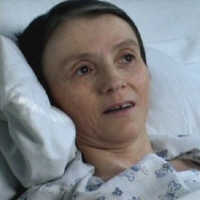
In the Romanian province of Transylvania, a woman is being eaten alive, consumed by a giant parasite on her back. Lucica Bunghez has a tumour that weighs an incredible eleven stone. Its so big and feeds off so much of her blood that she barely has the energy to move. She has been confined to her bed for the last three years. Doctors in Transylvania say that surgery to remove Lucica’s tumour would cause fatal bleeding. Inside, it is a tangled mass of arteries and viens. Cutting these, they say, world cause fatal bleeding. So, its been left to grow and grow.
Lucica’s heart is beginning to fail, she lies waiting to die! But, there is one surgeon who’s dared to operate on a tumour this size before and he’s going to try to make medical history again. But, will Lucica survive?
Brasov is in the heart of the Transylvanian mountains, and it was here that Lucica was born in 1957. She was a normal, healthy child who grew into an attractive young woman. She married and had a son. Lucica’s husband, Marian, still works in the same communist-era factory he has for decades. For the first eight years of marriage there was no sign that there was anything wrong with Lucica, until one day everything changed.
One evening, in the bath, she screamed and started banging on the wall. When Marian came to see what was the matter, the bath was full of blood. Marian phoned for an ambulance and she was taken to the district hospital in Brasov. The doctors told them that a blood vessel had burst in a patch of brown skin on her back, That brown patch was the tell-tale sign that Lucica had neurofibromatosis or NF.
NF is a genetic condition, a fault in a gene that regulates normal cell division means that cells start dividing out of control, It leads to the growth of benign tumours on nerves or nearofibromas. Mostly, nearofibromas remain quite small but, in Lucica’s case a tumour started to grow at an extraordinary rate over the next six years. The tumour was left to keep on growing by as much as 3lbs a month.
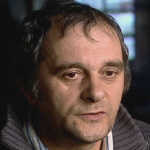
Lucica needed constant care, but Marian still had to go to work. The tumour didn’t get any better, it grew to an astonishing eleven stone. Whilst Marian worked, their son Marius had to spend all day, at home, caring for his mother. This seemed to be the life they were condemned to, Lucica bed-ridden with Marius caring for her by day and, by night, Marian nursing her to sleep. But, Lucica had one more chance!
On the other side of the world was a surgeon who had once before successfully removed another massive tumour but, as yet he was unaware of Lucica’s plight.
Four years ago, in Chicago, plastic surgeon McKay McKinnon successfully removed a massive tumour from a woman who, like Lucica Bunghez, had been told it was inoperable, Word reached him about Lucica’s predicament and her pleas for help. He responded “Knowing that our resources might be the only reasonable chance that she had, since she’s been turned down in more than one place, I wouldn’t be able to live easily with myself having turned her down”.
Dr Madelyn Kahana worked with Dr McKinnon on the previous giant tumour case. A specialist in anaesthetics and intensive care at the University of Chicago Hospital, it was to be her responsibility to keep Lucica alive during the lengthy operation.
McKinnon and Kahana set off for Romania, and with them went a hand-picked team of nurses. When Lucica’s family heard that the Americans were on their way, they drove her the hundred miles or so to from their home to the Romanian capital city of Bucharest. Lucica was admitted to the emergency hospital, one of Romania’s leading hospitals, where the operation was to be performed.
The American team were met, at the airport, by a large and lively contingent of the Romanian press.
McKay McKinnon and Professor Ioan Lascar, Romania’s leading surgeon, met for the first time and together began planning the operation. The idea was that Lascar’s skills and McKinnon’s experience of the previous operation would prove equal to this mammoth task.
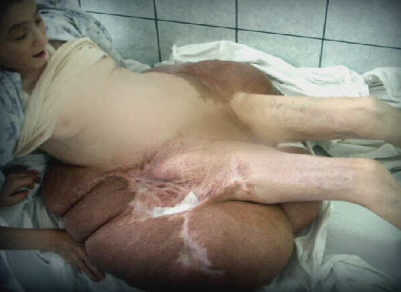
The tumour had grown from the base of Lucica’s spine , enveloping her back and wrapping around her thighs. It was tightly packed with blood vessels, so cutting chunks out of it would have caused massive bleeding. The surgeons agreed upon a strategy to try and peel the tumour off whole from Lucica’s sides before turning her over and prising it off her back. Professor Lascar had over thirty years experience of removing tumours, but this was the first time he’d seen Lucica or a tumour this size.
Lucica’s giant tumour is not cancerous, but its size makes it a deadly parasite, so it has to be removed to save her life.
Professor Lascar understands that before surgery they need to locate each of the hundreds of blood vessels feeding the tumour. Accidentally severing any one of these could cause fatal bleeding. The operation is going to be a 12 hour ordeal. Professor Lascar and Dr McKinnon know surgery is Lucica’s only chance, but that chance is only around 50%
In the weeks leading up to the operation, the hospital blood-bank appealed to the Romanian public to donate blood. The public responded and the fridges are packed and ready. Hearing that surgery is about to begin, the world’s media descends on the hospital’ Lucica’s plight has become global news.
The fifteen strong team of surgeons begin work. Anaesthesiologist Madelyn Kahana, carefully monitors Lucica’s already struggling heart in case the anaesthetic causes it to fail. Bit by bit, the tumour is removed from Lucica’s front and side. She’s monitored continuously for signs of haemorrhaging or heart attack.

Now, its time for the riskiest moment yet. Lucica must be turned over before the surgeons can begin prising the tumour off her back. The tumour is heavy enough to tear away under its own weight, so her body and the tumour must ne lifted and turned as one. She has multiple intravenous lines and a breathing tube, critical to keeping her alive. Turning her could risk losing all of this.
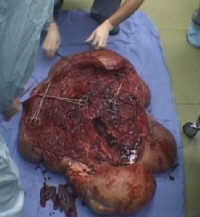
Its a struggle, and for a moment the tumour almost gets the better of them. After the turn, the surgeons are able to pick up the pace. The Romanians and Americans are working well as a team. They’re approaching the final stage of the operation, they have to tie off and cut the big blood vessels anchoring the tumour at the base of Lucica’s spine, before attempting to lift it off her.
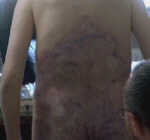
After 12 long hours, 28 units of blood and 30 units of plasma, comes the moment of victory, the tumour is finally separated from its host. It weighs a remarkable 70 kilos. Lucica, free from her parasite for the first time in years, can be bandaged up for recovery. Lucica has to be rushed into intensive care, right through the middle of the jostling press-pack.
Lucica is not yet out of danger. 40% of her body is now an open wound and over the next few weeks she will need many skin grafts to close it. Until then, her life will hang in the balance as she can catch infection and die at any time.
After nine months, finally she hopes her suffering is at an end. Professor Lascar has had to perform multiple skin grafts to close the giant wound on her back. Any infection during this time could have killed her. Lucica is finally ready to leave hospital and travel back to Brasov.
Lucica believes her recovery was an act of God, for her doctors it proves that neurofibroma tumours this size can be removed after all.
CREDITS: All of the above information came from the UK Channel 4 “Body Shock” Documentary Series
Additional Reading
[amazon template=template&title=-&artist=-&asin=1859961916] Neurofibromatosis Type 1: From Genotype to Phenotype - M. Upadhyaya, D. N. Cooper
[amazon template=template&title=-&artist=-&asin=1898683131] Neurofibromatosis Type 1 in Childhood - Kathryn North
